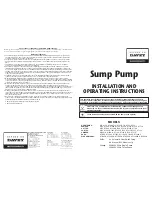
5
WARNING:
The table saw should never be connected to a power supply
when you are assembling parts. Disconnecting the saw
will prevent accidental starting that could cause serious
personal injury.
TOOLS NEEDED
You need an adjustable wrench and phillips screwdriver to assemble this accessory.
ASSEMBLY
Fig. 1
PLASTITE
SCREW
TAPERED GROOVE
MITER/RIP FENCE RAIL
(LONG MITER FENCE RAIL)
SAW GAGE
T-NUTS
MITER INDICATOR
RAIL ORIENTATION FOR LONG MITER FENCE SETUPS
#2 PHILLIPS
SCREWDRIVER
ADJUSTABLE
WRENCH
Fig. 2
MITER FENCE HOLDER
ADJUSTING KNOB
MITER
FENCE
MITER
INDICATOR
HOLE "B"
ATTACHMENT
BOLT
HOLE "A"
LOCATOR PIN
TABLE
SLOT
TO ASSEMBLE THE LOCATOR PIN
See Figures 1 and 2.
Unplug the saw.
Remove the miter fence, the miter fence holder, and the
adjusting knob from sliding miter table on your BT3000
/BT3100/BT3100-1 table saw.
Place the long miter fence rail on the sliding miter table.
See Figure 2.
IMPORTANT:
Rail must be oriented exactly as shown for
proper assembly of all parts.
Drilled holes in the rail are in the bottom channel when
using the rail as a long miter fence. Drilled holes are in the
top channel when using the rail as a long rip fence.
ASSEMBLE THE MITER INDICATOR
Align the miter indicator with the tapered groove on the
long miter fence rail.
Slide the miter indicator onto the rail. The bottom of the
miter indicator should be next to the sliding miter table.
Note:
The miter indicator for the long miter fence is the
same as the miter indicator on the miter fence provided
with your BT3000/BT3100/BT3100-1 table saw. Use the
miter indicator with the scale on the sliding miter table to
set desired angles for making miter cuts
Slide the locator pin into the bottom channel of the long
miter fence rail.
Note:
The locator pin assembled to the miter fence
provided with your BT3000/BT3100/BT3100-1 table saw
is assembled identical to this assembly.
This locator pin fits in either hole "A" or hole "B" when mounting
the long miter fence to the sliding miter table.
Note:
Raised ribs on the locator pin create a tight fit when
installing the locator pin. It may be necessary to force the
locator pin into the holes at first.
See Figure 2.
ASSEMBLE THE T-NUTS
Slide two of the T-nuts into the bottom channel of the long
miter fence rail. T-nuts will be used later to secure the
brackets. The T-nuts must be placed in the channel before
assembling the plastite screws. The plastite screws trap
the T-nuts inside the channel.




























